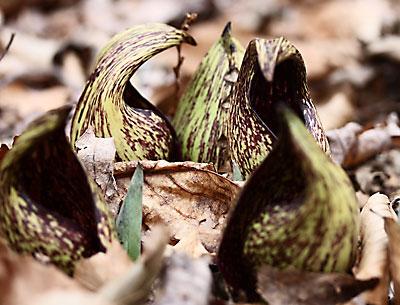Nature Notes: Here Comes Spring

One more storm and then spring’s a-poppin’. In Noyac on Friday daffodils and daylilies began to sprout. Two weeks ago skunk cabbages were in bloom in Morton Wildlife Refuge in Noyac and at Big Reed Pond in Montauk. As of last Friday, deer ticks, both the blackish males and reddish-backed females, were crawling onto shoes, socks, and trousers in the shrub lands in Montauk east of the lake.
For the past week cardinals, white-breasted nuthatches, and Carolina wrens have been singing up a storm. Our year-round resident birds brave the cold for the opportunity to breed ahead of those coming up from the south. It’s a crapshoot of sorts. They breed ahead of the others, but there is the chance that early spring storms will wipe their nests and nestlings out.
“Spring is getting a wiggle on,” as my mother used to say.
Great horned owls are already feeding their young. In two weeks the ospreys will be returning. One or two will show up in less than a week. Piping plovers will follow on their heels.
Male red-winged blackbirds and grackles have been putting up a chatter for two weeks now. For some reason they come up a week or two earlier than the females. Robin males also arrive first, but it’s hard to tell the snowbird robins from the ones that stayed with us throughout the winter. Since Feb. 20 they’ve been checking out the weedy road shoulders and larger lawns. It’s the early robin that gets the worm, and after last week’s rain melted the snow, little brown chimneys of dirt on local lawns announced the first emergence of night crawlers and red wrigglers.
Alewives, what few are left in our marine waters, are massing in the harbors and bays at the mouths of streams running out of ponds such as Big Fresh Pond in North Sea, Jeremy’s Hole in Sagg Swamp, Mill Pond in Water Mill, and Scoy Pond in East Hampton’s Northwest. They’re the closest fish, behaviorally, to salmon and sea-run trout that we have on the East End. Long ago we had the Atlantic salmon nosing about come spring but those days are gone forever. Some of the alewives will be bearing well-developed freshwater clam larvae on their gills, which will be released into the alewives’ breeding waters to then settle down and start long lives as sedentary bivalves. Do these bivalves-to-be come back to the same ponds in which they were spawned? Science is still trying to answer that question.
Elvers three or four inches long leaving the “glass” stage, becoming pigmented, will be swimming up the same streams a week or two later. They have to surmount dryish spots, wood snags, phragmites and all sorts of gauntlets to make it to headwater ponds where they, just as the clams, will grow up into adults. Obstacles in their watery path are no match for them. After all, they come more than 1,000 miles to get here, all the way from the Sargasso Sea!
Andy Sabin observed adult tiger salamanders entering their Southampton breeding ponds as early as Jan. 15, but the other mole salamanders, the spotteds and blue spotteds that breed in the spring, are just coming out of their winter hibernacula now. When you hear the first spring peepers — those tiniest of Long Island frogs — begin to sing near the end of the month, you will know that the salamanders, which are silent, will be there with them sharing the waters, courting and laying and fertilizing their eggs in the same two-week time span.
Ironically, at the very same time, the tadpoles of our fourth mole salamander, the marbled salamander, having been conceived in September, will be approaching metamorphosis time, leaving the water for a terrestrial existence as the other three species’ tadpoles are just getting started.
The snakes and turtles will come out of hibernation a little later. If they get caught above ground in freezing temperatures for more than a few hours it could be curtains. Diamondback terrapins emerge from mud in salt ponds, snapping turtles from their winter hug-the-bottom still-life existence.
The mammals are shaking off their winter sluggardliness. In two weeks you will see woodchucks sitting up watching the cars go by on the Sunrise Highway. Chipmunks will pop their noses out of their winter burrows and smell the air. Raccoons and opposums, which have been slumberous through the hardest parts of winter, will get up and get going. Pregnant females will be looking for birthing spots in chimneys, deserted sheds, hollow trees, under decks, and so on.
Flowers will start to pop when the spring peepers begin to sing. Witch hazels have been blooming for almost a month. Members of the mustard family, the brassicas, both native and exotic, will follow along with the trailing arbutus. Then come the shads, dogwoods, cottonwoods, bird’s-foot violets, star flowers, and wood anemones. To paraphrase Shelly, “when winter comes, can spring be far behind?” Fasten your seat belts, folks, spring’s a-comin’ and it won’t stop for no one.
